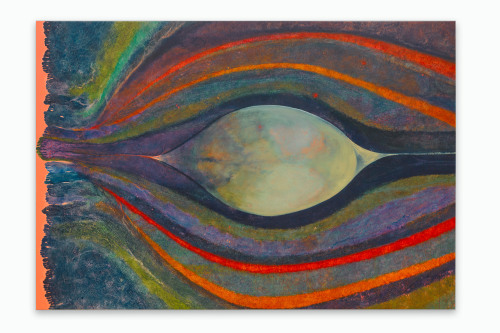
Luisa Rabia, I am Rainbow, 2020, 87 x 128 inches, oil on canvas
Nine Works
Jessie Elizabeth Alperin
July 2021
The relationship between oneself and others, from the micro- to macrocosm, from the physical to the spiritual is fascinating to me. The way our lives are shaped by rationality and unconsciousness, the connection between our present actions and past and future are reflections dear to me because they increase our sense of responsibility and belonging. I approach my work with this same spirit, technically and visually, letting it grow through marks and traces over a surface that always suggests to me where to go in a relation of trust between the known and unknown. I speak of what I feel and experience, but focusing mostly on positive messages that might bring people together rather than apart.
At the core of my research is drawing, where lines, over the course of my career, have extended from works on paper to painting, sculpture and video. Until 2018 mostly of my paintings were executed entirely with colored pencil over a monochromatic layer of acrylic paint laid down, not with brush, but with thick fingerprints. When drawn over, the texture from the fingerprints is highlighted creating detail and visual complexity. In addition to the process described above, recently I began working with oil paint, which has drying times slow enough to allow scratching into the surface, a process of subtraction that reveals what’s underneath.
One reading of the fingerprints is that they are the accumulation of traces, but in different contexts they assume different meanings. In some works they are reminiscent of biometrics which, however, represent the unique identity of individuals without revealing information about gender, race or nationality. In the large-scale paintings, the fingerprints look like microscopic particles, as if the human trace has dissolved into the cosmos mixing with bacteria and dust.
While situated securely in the contemporary moment, ultimately, I seek for an atemporal language, one that motivates humanity beyond the quotidian. I am interested in visual expressions that seek a language of kinship, both socially and ecologically. In a world of fragmentation, I am seeking a discourse that connects, and could possibly raise sentiments of empathy. My work reflects on the self and speaks of inner landscapes that are either protected by boundaries or boundless and open to otherness. Despite the fact that the fingerprints on the surface of my paintings are mine, they extend to dissolution. It is my body (and my sense of responsibility) that spreads, shifting between internal and external, blurring the personal with the collective, the physical with the ethereal.
In Chorus, seven indeterminate figures stand facing the viewer, layering themselves upon the other to create the impression of a single body, a single pulsating diaphragm, and a single vibratory breath that radiates outwards with the expansion and disappearance of bodies. As the title of the painting suggests, these figures are united beyond the layered forms of the composition and join together as one voice, one song, and one company. The very process of respiration joins one to another through the space of shared air and inspiration. Luisa Rabbia’s artwork manifests these spaces in visual, tactile, and emotional forms to draw us into the shared domain of breathing to reflect upon ourselves and our relation to each other. Paintings like Chorus depict both the daily action of unconscious inhalation and exhalation. However, beyond this commonality of breathing, Rabbia expresses an intense spiritual intimacy that encompasses the ethereal life force of breath beyond human form.
These impressions of a deep, yet mysterious intimacy between the personal and collective, as well as the known and the unknown, extend from the macroscopic impression of the paintings to Rabbia’s tactile quality of mark-making. Her works compose a topography of her own fingerprints that haptically map her presence and absence within each painting or drawing. Reimagining familiar landscape scenes with her visceral touch, Rabbia’s multi-layered surfaces use her fingerprints to describe the physical location of her body in relation to each paper or canvas. Yet, definite forms are foregone for the ambiguity of inner psychological drama or emotional energy. The upper supine human form in Death transforms into a tree as their last breaths spark with embers into faded memories. The composition of rootlike forms in Death amid the blue intensity of an oceanic cosmos or starry sky leaves the viewer with the feeling of solitude amidst interconnection, the closeness of touch at a distance, and the notion of those whom we have lost along the way. As much as we see the possibilities of living, the subtlety of Rabbia’s work allows us to remember that there is always a precarity in breathing.